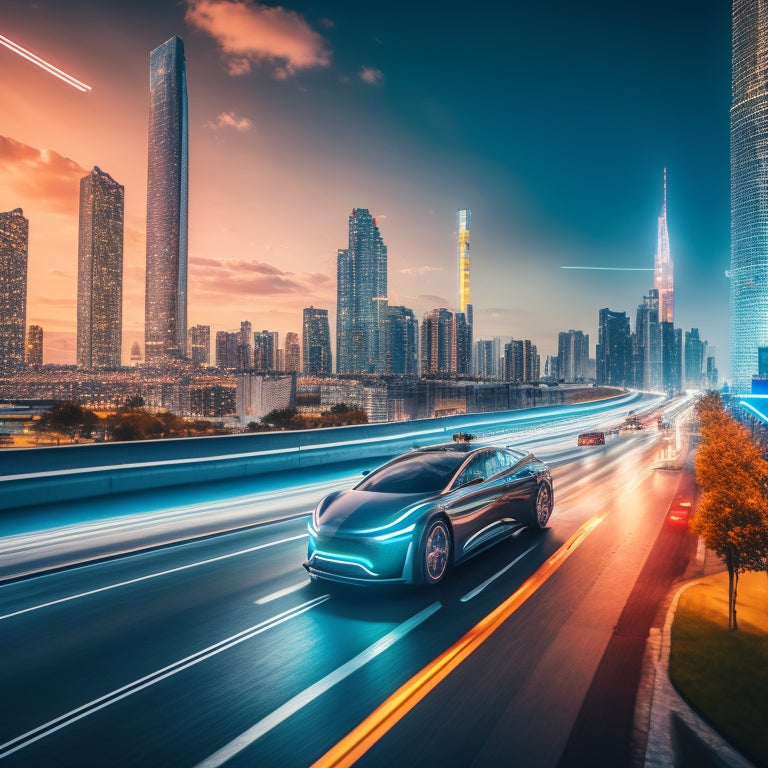
Revolutionizing Transportation: The Electric Vehicle Chronicles
Share
The history of electric vehicles is a complex narrative of innovation and competition, marked by forgotten innovations, technological shifts, and a century-long struggle to revolutionize transportation. Electric vehicles, once poised to dominate the automotive industry, were ultimately overshadowed by the rise of fossil fuels. Despite historic obstacles, electric vehicles persisted, driven by environmental benefits and disruptive potential. Today, the electric future gains momentum, threatening to upend the fossil fuel-based paradigm. As the world grapples with climate change and air pollution, the electric vehicle chronicles become increasingly relevant, holding valuable lessons for a sustainable transportation future ahead.
Key Takeaways
• Electric vehicles have a hidden history of innovation and competition, with pioneers like Morrison Electric and Detroit Electric paving the way for sustainable solutions.
• The rise of fossil fuels overshadowed EVs, but environmental benefits and disruptive potential kept the electric dream alive, gaining momentum again due to climate concerns.
• Early 20th-century EVs rivaled gasoline-powered counterparts, but limited range, high cost, and large oil reserves hindered widespread adoption.
• Inadequate infrastructure, inconsistent policies, and technological hurdles slowed EV progress, but lessons from the past inform current developments.
• Applying past lessons can pave the way for a more sustainable transportation future, with EVs offering reduced emissions and quieter operation.
Uncovering the Hidden History
Through a meticulous examination of archival records and historical accounts, the hidden history of electric vehicles reveals a narrative of innovation, competition, and ultimately, the suppression of an alternative transportation technology.
Forgotten innovations and technological shifts have led to the marginalization of electric vehicles, overshadowed by the dominance of internal combustion engines. Overlooked pioneers, such as Morrison Electric and Detroit Electric, paved the way for sustainable solutions, only to be forgotten in the annals of history.
Electric Dreams and Gasoline Nightmares
One hundred years ago, the electric vehicle (EV) was poised to revolutionize the automotive industry, promising a cleaner, quieter, and more efficient alternative to gasoline-powered vehicles. However, the EV's potential was overshadowed by the rise of fossil fuels, which dominated the market for decades.
As a result, the electric future that once seemed imminent was relegated to the fringes of the automotive landscape. Despite this, the allure of electric vehicles persisted, with proponents touting their environmental benefits and potential to disrupt the status quo.
Today, as concerns about climate change and air pollution mount, the electric future is once again gaining momentum, threatening to upend the fossil fuel-based paradigm and usher in a new era of sustainable transportation.
The Rise and Fall of EVs
During the early 20th century, electric vehicles (EVs) gained popularity, with manufacturers like Detroit Electric and Morrison Electric producing EVs that rivaled their gasoline-powered counterparts in terms of performance and luxury.
However, their rise was short-lived, as they eventually fell out of favor due to limited range, high cost, and the discovery of large oil reserves. The environmental impact of EVs was not a significant concern at the time, but technological advancements in battery technology and policy implications of government incentives could have altered the course of history.
Despite market trends favoring gasoline-powered vehicles, EVs continued to evolve, laying the groundwork for their modern resurgence.
Challenges Beyond the Road
Beyond the challenges of range and cost, electric vehicles faced a complex web of obstacles that hindered their widespread adoption, including inadequate charging infrastructure, inconsistent government policies, and the entrenched interests of the petroleum industry. These systemic impacts extended beyond the road, encompassing technological hurdles that slowed EV progress.
The lack of standardization in charging systems, for instance, created confusion among consumers and hindered the development of a seamless charging experience. Moreover, the dominance of internal combustion engines had led to an entrenched supply chain, making it difficult for EVs to gain traction.
Addressing these challenges beyond the road is essential to overcoming the barriers that have hindered EV adoption, and ultimately, to revolutionizing the transportation sector.
Lessons From the Past
As the automotive industry continues to grapple with the challenges of electric vehicle adoption, it is essential to examine the historical context of EV development to glean valuable insights from past successes and setbacks.
By studying the past, we can uncover the underlying factors that influenced the rise and fall of electric vehicles in the early 20th century. Historical analysis reveals that technological limitations, lack of standardization, and inadequate infrastructure hindered widespread adoption.
Conversely, past lessons also highlight the benefits of electric vehicles, such as reduced emissions and quieter operation. By applying these past lessons, we can inform current policy and technological developments, ultimately paving the way for a more sustainable transportation future.
Frequently Asked Questions
What Sparked the Initial Interest in Electric Vehicles in the Late 19TH Century?
In the late 19th century, French innovators, driven by urban congestion and pollution concerns, explored electric vehicles as a solution, prompted by the need to modernize city infrastructure and improve urban mobility.
How Did World War I Impact the Development of Electric Vehicles?
"Necessity is the mother of invention" aptly describes World War I's impact on electric vehicles, as the war effort spurred battery innovation, driving advancements in electric vehicle technology to support the military's logistical needs.
What Role Did Government Regulations Play in the Decline of Electric Vehicles?
Government regulations, particularly the lack of tax credits and exploitation of regulatory loopholes, contributed to the decline of electric vehicles, hindering their widespread adoption and allowing internal combustion engines to dominate the market.
Can Electric Vehicles Be Charged Using Renewable Energy Sources?
Electric vehicles can be charged using renewable energy sources, such as solar power, through solar integration, and advanced energy storage systems, enabling a sustainable and environmentally friendly transportation solution.
Are There Any Modern-Day Applications of Historical Electric Vehicle Technologies?
Modern-day applications of historical electric vehicle technologies include Vintage Revival initiatives, where retro innovations are repurposed for sustainable mobility, and innovative startups leveraging Retro Innovation to develop eco-friendly transportation solutions.
Related Posts
-

7 Best Home Hydrogen Fuel Cells for Clean Power
You're considering adopting hydrogen fuel cells for clean power at home, but you want to know the best options. Reput...
-

3 Green HVAC Filters for Solar-Powered Homes
When outfitting your solar-powered home with an HVAC system, you'll want to choose filters that align with your commi...
-

Why Biodegradable Dish Soap Matters for Earth-Conscious Homes
You likely don't realize that the dish soap you're using today will still be harming the environment long after you'v...


